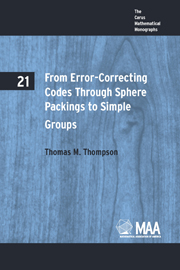Book contents
- Frontmatter
- PREFACE
- Contents
- CHAPTER 1 THE ORIGIN OF ERROR-CORRECTING CODES
- CHAPTER 2 FROM CODING TO SPHERE PACKING
- CHAPTER 3 FROM SPHERE PACKING TO NEW SIMPLE GROUPS
- APPENDIX 1 DENSEST KNOWN SPHERE PACKINGS
- APPENDIX 2 FURTHER PROPERTIES OF THE (24,12) GOLAY CODE AND THE RELATED STEINER SYSTEM S(5, 8, 24)
- APPENDIX 3 A CALCULATION OF THE NUMBER OF SPHERES WITH CENTERS IN Λ2 ADJACENT TO ONE, TWO, THREE AND FOUR ADJACENT SPHERES WITH CENTERS Λ2.
- APPENDIX 4 THE MATHIEU GROUP M24 AND THE ORDER OF M22
- APPENDIX 5 THE PROOF OF LEMMA 3.3
- APPENDIX 6 THE SPORADIC SIMPLE GROUPS
- BIBLIOGRAPHY
- INDEX
CHAPTER 2 - FROM CODING TO SPHERE PACKING
- Frontmatter
- PREFACE
- Contents
- CHAPTER 1 THE ORIGIN OF ERROR-CORRECTING CODES
- CHAPTER 2 FROM CODING TO SPHERE PACKING
- CHAPTER 3 FROM SPHERE PACKING TO NEW SIMPLE GROUPS
- APPENDIX 1 DENSEST KNOWN SPHERE PACKINGS
- APPENDIX 2 FURTHER PROPERTIES OF THE (24,12) GOLAY CODE AND THE RELATED STEINER SYSTEM S(5, 8, 24)
- APPENDIX 3 A CALCULATION OF THE NUMBER OF SPHERES WITH CENTERS IN Λ2 ADJACENT TO ONE, TWO, THREE AND FOUR ADJACENT SPHERES WITH CENTERS Λ2.
- APPENDIX 4 THE MATHIEU GROUP M24 AND THE ORDER OF M22
- APPENDIX 5 THE PROOF OF LEMMA 3.3
- APPENDIX 6 THE SPORADIC SIMPLE GROUPS
- BIBLIOGRAPHY
- INDEX
Summary
Section 1. An Introduction to Sphere Packing
In Euclidean n-space, En, how may disjoint, open, congruent n-spheres be located to maximize the fraction of the volume of En that the n-spheres cover? That is the sphere packing problem, which goes back to a book review that Gauss wrote in 1831, in which he pointed out that a problem concerning the minimal nonzero value assumed by a positive definite quadratic form in n variables, first considered by Lagrange in 1773, could be translated into a problem on packing spheres (cf. C. A. Rogers [105, pp. 1, 106]).
Though there might seem to be no connection between coding theory and sphere packing, John Leech in [72] and [74] used results in coding theory to obtain a packing of E24 that was much denser than any previously known. The present chapter will describe his packing and discuss how he happened to bridge the gap, so to speak, from codes to sphere packings.
The (23, 12) Golay code can be extended to a (24, 12) code by adding a 0 or 1 to each codeword so that all code-words have even weight. This (24, 12) Golay code thus has a minimum codeword distance of eight.
- Type
- Chapter
- Information
- Publisher: Mathematical Association of AmericaPrint publication year: 1983



